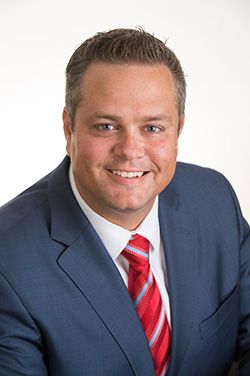How We Help Our Healthcare Partners Achieve the Triple Aim
By Nick Westfall, Chief Executive Officer, VITAS Healthcare
Triple Aim provides the opportunity for different providers across the health care spectrum—acute and post-acute—to improve patient outcomes while reducing cost through appropriate transitions of care at the right time based upon a patient’s goals of care. Our goal as the nation’s largest hospice provider is to further align palliative and hospice care across the healthcare continuum while also helping patients and their families appropriately and thoughtfully transition into the hospice benefit at the right time.
helping patients and their families appropriately and thoughtfully transition into the hospice benefit at the right time.
Decades of research continues to demonstrate that the building blocks of hospice are designed to achieve exactly what the Triple Aim is designed to do - improve the health of populations, particularly the older adult and terminally ill, through an enhanced patient experience that simultaneously lowers Medicare spending per beneficiary across the care continuum. Patients near the end-of-life and their families seek high quality care at the right place and the right time, and the majority is able to have it provided in their setting of choice, at home surrounded by loved ones. VITAS helps hospitals achieve the Triple Aim by acting as a trusted partner to coordinate discharge planning and transition of care from the hospital facility onto the hospice benefit.
A number of studies document that 80 to 90 percent of people prefer to die at home, and unfortunately only one-third are currently able to do so. This is where a mature, end-of-life provider such as VITAS can partner with hospitals (and all healthcare providers) to help transition hospice-appropriate patients efficiently to the appropriate setting. Recent studies have highlighted that 30 percent of patients who have passed had a visit to the ICU in their last month of life, and 50 percent experience at least one emergency room visit in the last month of life. Hospice provides a great opportunity to transition patients in a more timely fashion, while keeping them comfortable and improving their quality of life. Our patient- and family-centered approach starts with our interdisciplinary team (physician, nurse, aid, social worker, chaplain) throughout their stay on hospice as well as provides bereavement support for that patient’s family upon death, which VITAS provides indefinitely as long as any family member desires this support.
From a cost perspective, the Journal of the American Geriatrics Society published a study last year that found one-third of Medicare beneficiaries go through four or more transitions of care in the last six months of life. This can include transitions between the hospital, nursing home, home health and hospice, which generally does not align with patient and family goals, provides poorer quality of care, and is not cost-effective. VITAS and other post-acute providers can help reduce the cost of healthcare by working together to eliminate unnecessary and often burdensome transitions.
A Kaiser Foundation study recently illustrated that roughly 25 percent of all traditional Medicare spending for healthcare takes place in the last year of life. By partnering with other healthcare providers, we can help them achieve Triple Aim; in fact, a Health Affairs study shows roughly $2,500 lower overall costs in patients who elected hospice compared to those who did not prior to death. Another study that focused on oncology patients published in the Journal of the American Medical Association found those who died with the benefit of hospice cost about $8,700 per patient less on average compared to those who died without the benefit. Moreover, almost 75 percent of the non-hospice group died in either the hospital or a skilled facility, potentially adversely affecting the hospital’s mortality rate.
By providing robust end-of-life care, as well as helping with care transitions, education and awareness, and advance care planning, VITAS serves as an extension to help our healthcare partners achieve Triple Aim. Our interdisciplinary team can evaluate the patient and coordinate care in the setting of choice and provide high quality care through end-of-life, helping to reduce/eliminate unnecessary hospital emergency room visits and hospital readmissions.
We leverage mobile technology to not only assist our employees across the country, but also work seamlessly with other providers to build interoperability with their EMR/EHR systems. When a hospice patient is identified, we can effectively and efficiently use our electronic platform to deploy our care team, admissions nurses and patient concierges to coordinate the discharge process.
We will continue to expand our interoperability platform, which will benefit our partners as they become more incentivized to coordinate a hassle-free, timely transition of care. We continue to make significant investments around our business intelligence and enterprise data warehouse capabilities to provide a mature platform to securely and dynamically share outcome-based information for all of our healthcare partners throughout the country. We are able to share information with physicians and health systems which refer patients to VITAS in the event that they want to measure the benefits of appropriately identifying and coordinating end-of-life care within how they measure themselves for Triple Aim.
In all value-based reimbursement models, our partners would have a vested interest in whether we took appropriate care of patients through providing a cost-effective setting of care, while improving their overall quality and satisfactions scores. We can share this information with them in a secure, HIPAA-protected fashion, providing transparency to all.
Since the inception of VITAS, we have measured our results on all three dimensions of Triple Aim - improving the patient experience, improving the health of populations and reducing the per capita cost of health care - as each of these dimensions reflects the purpose of the hospice benefit.
This message also appeared in the South Florida Hospital News and Healthcare Report in July 2017.

Check Hospice Guidelines
Get diagnosis-specific guidelines in our hospice eligibility reference guide.
Hospice Guidelines by Diagnosis Refer Your Patient